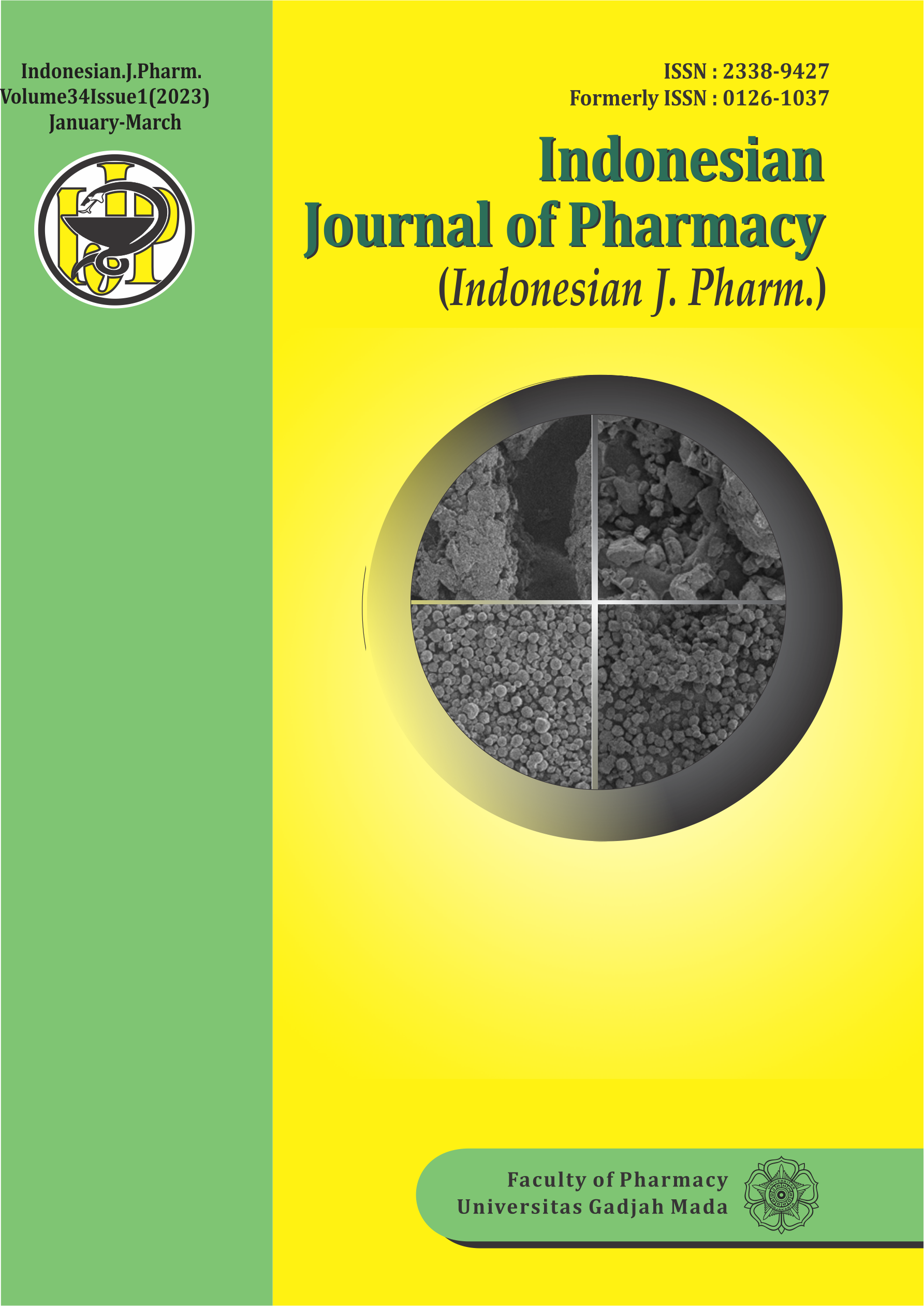Optimization of Gelling Agent and Sunscreen Activity Test of 4-OH-chalcone Gel by In Vitro Method
Abstract
ABSTRACT
The 4-OH-chalcone was suspected to absorb and reduce ultraviolet radiation intensity that exposed to the skin. The 4-OH-chalcone was formulated as gel dosage form using combination of carbopol in content of 0.50-1.00% w/w; propylene glycol in content of 19-20% w/w; and CMC-Na in content of 0.50-1.00% w/w. This study’s purpose was to optimize the three gel bases, evaluate physical properties, physical stability, and activity of 4-OH-chalcone gel as sunscreen by in vitro method. Simplex Lattice Design (SLD) method was used to optimize gel base with Design Expert software version 10.0. Activity of 4-OH-chalcone gel as sunscreen was determined spectrophotometrically by determining Sun Protecting Factor (SPF) value, percent transmission of erythema (% TE), and percent transmission of pigmentation (% TP). Data were analyzed statistically with SPSS Statistic software. Optimum formula of 4-OH-chalcone gel with 0.50% w/w carbopol content, 0.50% w/w carboxymethylcellulose sodium content, and 20,0% w/w propylene glycol content has pH of 5.59, viscosity of 37.4 dPa.s, spreadability of 28.8 cm2, adhesive time of 1.28 seconds, SPF value of 28.65, %, TE value of 16.44%, %TP value of 0.24%, and relatively stable physical properties.
References
Anggraeni, Y., Hendradi, E., & Purwanti, T., 2012, Preparation and Release Characteristics of Diclofenac Sodium in Niosomal System with Gel Base Carbomer 940, PharmaScientia, 1(1), 1-10.
Anonim, 2015, 4-Hydroxychalcone, https://pubchem.ncbi.nlm.nih.gov/compound/4-Hydroxy-chalcone, 22 June 22, 2020.
Bolton, S., & Bon, C., 2009, Pharmaceutical Statistic: Practical and Clinical Applications, 5th Ed., CRC Press, Florida.
Draelos, Z.D., & Thaman, L.A., 2006, Cosmetic Formulation of Skin Care Products, 75, 135-137, 157-161, Taylor and Francis Group, New York.
Fitrianingsih, V., 2018, Gelling Agent Optimization of Karbopol, CMC Natrium, and Gelatine as well as activity test of Gell 3-Nitrokalkon as a sunscreen in vitro, Skripsi, Fakultas Farmasi Universitas Gadjah Mada, Yogyakarta.
Helms, R.A., Quan, D.J., Herfindal, E.T., & Gourley, D.R., 2008, Textbook of Therapeutics: Drug and Disease Management, 8th Ed., 221-222, Lippincott Williams & Wilkins, USA.
Jones, A.E., 2000, A Spectroscopic Study of Sunscreens, Tesis, Durham University, United Kingdom.
Juzeniene, A., & Moan, J., 2012, Beneficial Effects of UV Radiation other than Via Vitamin D Production, Dermatoendocrinology, 4 (2), 109-117.
Kumar, V.R., & Kumar, S., 2011, Formulation and Evaluation of Mimosa pudica Gel, International Journal of Pharmacy and Pharmaceutical Sciences, 3 (1), 55-57.
Lann, K.L., Surget G., Couteau C., Coiffard L., Cerantola S., Gaillard F., Larnicol M., Zubia M., Guerard F., Poupart N., & Pouvreau V.S., 2016, Sunscreen, Antioxidant, and Bactericide Capacities of Phlorotannins from the Brown Macroalgae Halidrys siliquosa, Journal of Applied Phycology, 28 (6), 3547–3559.
Nursal, FK, Indriani, O., & Dewantini, LA, 2010, Use of Na-CMC as a Gelling Agent in Formula Toothpaste Ethanol Extract 70% Guava Leaves (Psidium Guajava L), Pharmacy UHAMKA, 1 (1), 45- 51.Rowe, R.C., Shesky, P.J., & Quinn, M.E., 2009, Handbook of Pharmaceutical Excipient, 6th Ed, Pharmaceutical Press. Inc, London.
Riddick, J.A., Bunger, W.B., Sakano, T.K., 1985, Techniques of Chemistry 4th ed.,
Shi, L., Shan, J., Ju, Y., Aikens, P., & Prud’homme, R.K., 2012, Nanoparticles as Delivery Vehicles for Sunscreen Agents, Colloids and Surfaces A: Physicochemical and Engineering Aspects, 396, 122-129.
Shovyana, H.H., & Zulkarnain, A.K., 2013, Physical Stability and Activity of Cream W/O Ethanolic Fruit Extract of Mahkota Dewa (Phaleria macrocarpa (scheff.) Boerl,) as a Sunscreen, Traditional Medicine Journal, 18 (2), 109-117.
Solomon, V.R, & Lee H., 2012, Anti-Breast Cancer Activity of Heteroaryl Chalcone Derivatives, Biomedicine & Pharmacotherapy, 66 (3), 213-220.
Indonesian National Standard 164954.1998, Skin whitening cream. Jakarta: National Standardization Agency.
Tahir, I., Jumina, & Yuliastuti, I., 2002, Analysis of In Vitro and In Vivo UV Protection Activities of Several Cinnamic Ester Compounds Condensation Reaction Products of Substituted Benzaldehyde and Alkyl Acetates, Paper at National Seminar on Chemistry XI Department of Chemistry, FMIPA UGM .
Taufikkurohmah, T., 2005, Synthesis of p-Methoxy-Cynnamil-p-Metoxycinamate from Ethyl P-Methoxycinamat was Isolated from Dried Rhizoma Kaempferia galanga L. as Sunscreen Compound, Indonesian Journal of Chemistry, 5 (3), 193-197.
Wang, Q., & Li, L., 2005, Effects of Molecular Weight on Thermoreversible Gelation and Gel Elasticity of Methylcellulose in Aqueous Solution, Carbohydrate Polymers, 62 (3), 232–238.
Wilkinson, J.B., & Moore, R. J. (1982) Harry’s Cosmeticology, 7th Ed. New York: Chemical Publishing Company.
Young, A.R., Chadwick, C.A., Harrison, G.I., Nikaido, O., Ramsden, J., & Potten, C.S., 1998, The Similarity of Action Spectra for Thymine Dimers in Human Epidermis and Erythema Suggests that DNA is the Chromophore for Erythema, Journal of Investigative Dermatology, 111 (6), 982–988.
Yumas, M., 2016, Formulation of Facial Cream Preparations with Active Ingredients Methanol Extract Non Fermented Cocoa Seeds (Theobroma Cacao L) Combination of Bee Honey, Journal of the Plantation Industry, 11 (2), 75-87.








